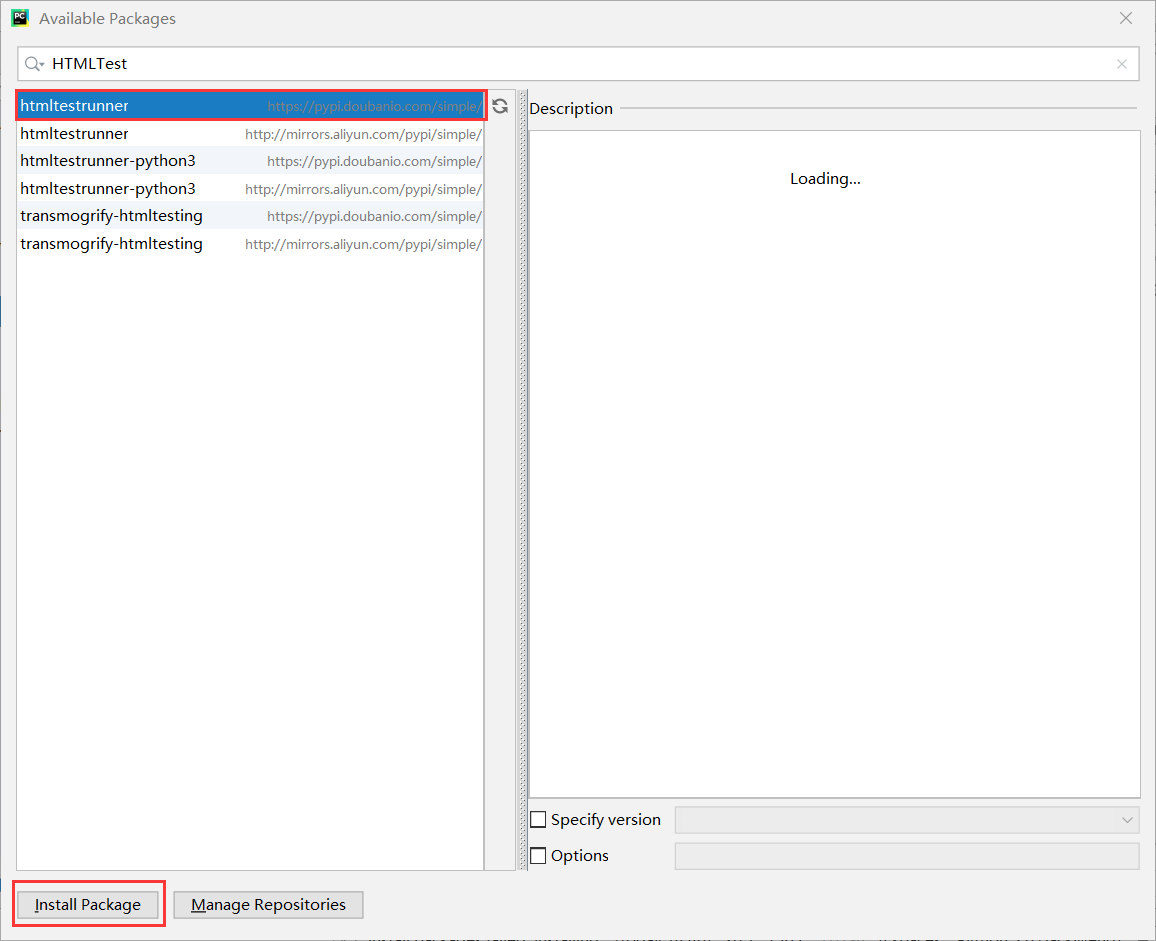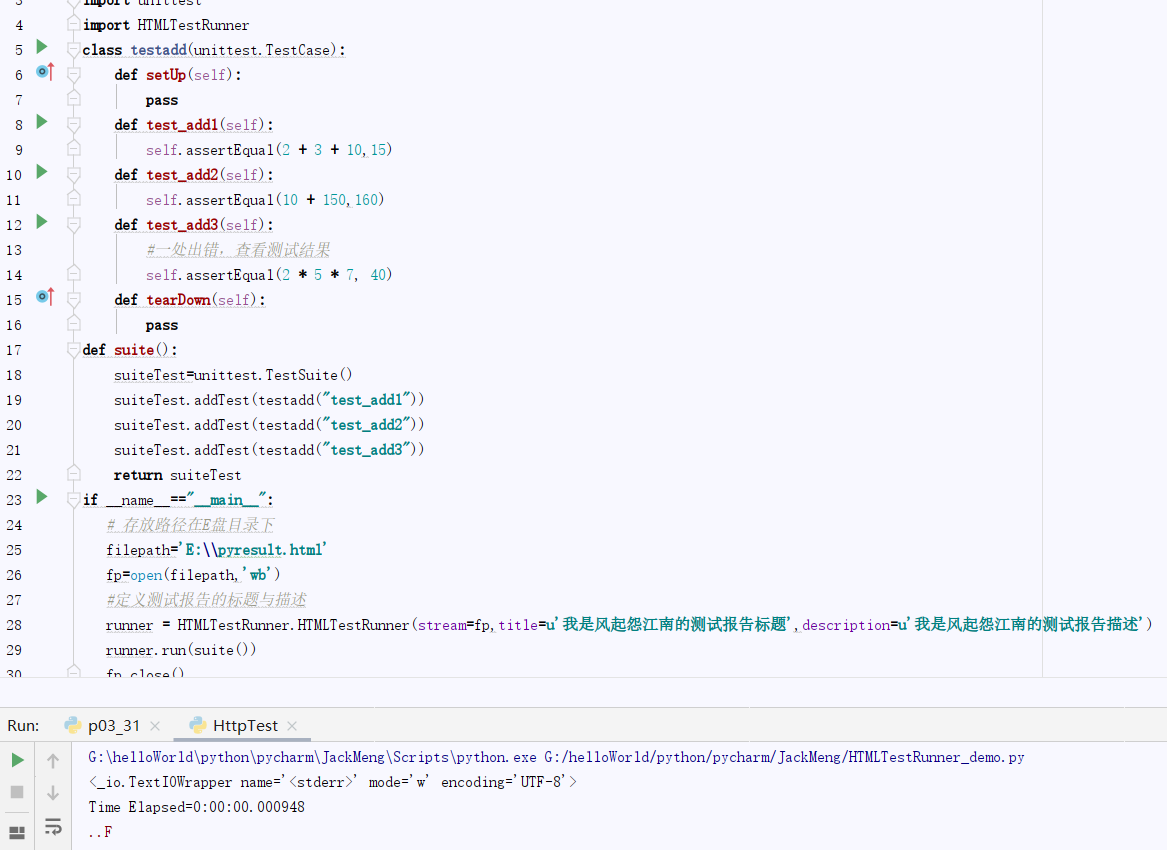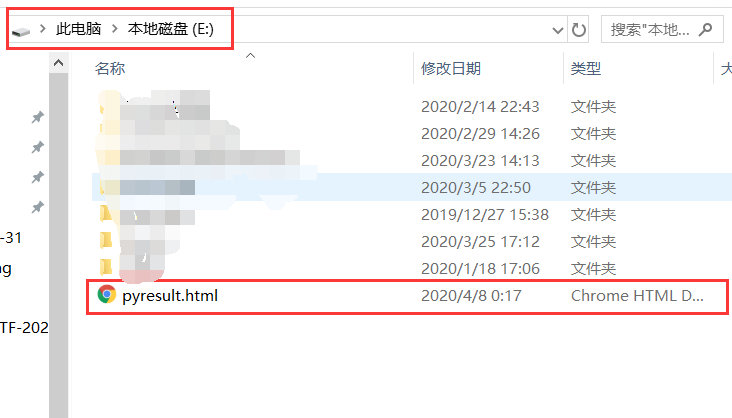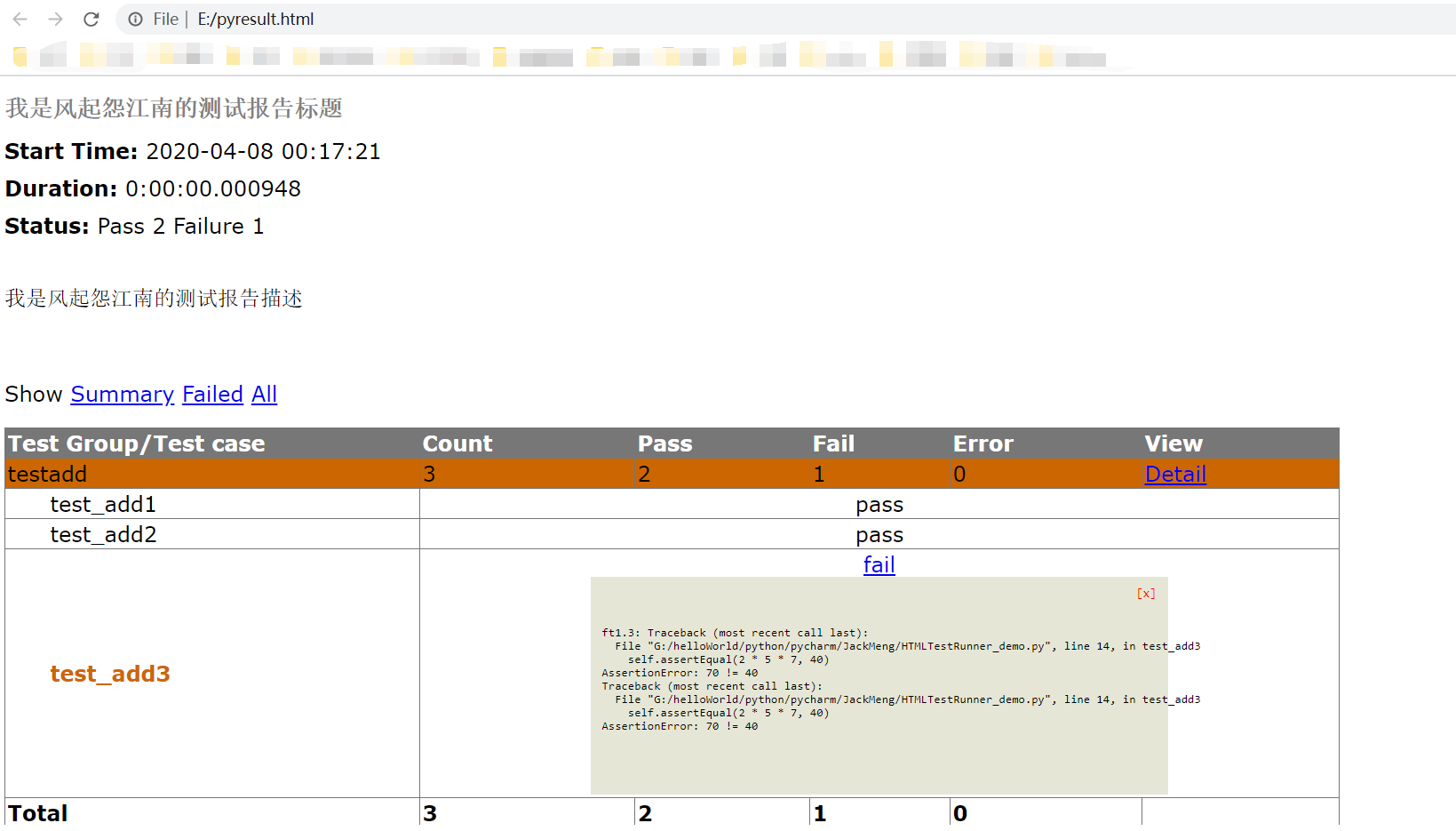筆者:風起怨江南 出處:https://www.cnblogs.com/mengjinxiang 筆者原創,文章歡迎轉載,如果喜歡請點贊+關註,感謝支持! 前言:最近一直在其他博客論壇上寫Python的相關技術博客->https://blog.csdn.net/JackMengJin,計劃還是在博客 ...
筆者:風起怨江南 出處:https://www.cnblogs.com/mengjinxiang 筆者原創,文章歡迎轉載,如果喜歡請點贊+關註,感謝支持!
前言:最近一直在其他博客論壇上寫Python的相關技術博客->https://blog.csdn.net/JackMengJin,計劃還是在博客園上寫一些關於安裝、排錯、爬坑等等一些零散的技術點,這樣感覺好一點(輕微強迫症患者= =)。
操作:
1.什麼是HTMLTestRunner?
在網上(包括在Python官方文庫)找不到HTMLTestRunner相關解釋資料。其實HTMLTestRunner是一個第三方的unittest HTML報告庫,關於unittest在Python官方文庫上很容易找到:https://docs.python.org/zh-cn/3.7/library/unittest.html#assert-methods,下麵是截取的部分說明:
unittest單元測試框架是受到 JUnit 的啟發,與其他語言中的主流單元測試框架有著相似的風格。其支持測試自動化,配置共用和關機代碼測試。支持將測試樣例聚合到測試集中,並將測試與報告框架獨立。為了實現這些,
unittest通過面向對象的方式支持了一些重要的概念。測試腳手架
test fixture 表示為了開展一項或多項測試所需要進行的準備工作,以及所有相關的清理操作。舉個例子,這可能包含創建臨時或代理的資料庫、目錄,再或者啟動一個伺服器進程。
測試用例
一個測試用例是一個獨立的測試單元。它檢查輸入特定的數據時的響應。
unittest提供一個基類:TestCase,用於新建測試用例。測試套件
test suite 是一系列的測試用例,或測試套件,或兩者皆有。它用於歸檔需要一起執行的測試。
測試運行器(test runner)
test runner 是一個用於執行和輸出測試結果的組件。這個運行器可能使用圖形介面、文本介面,或返回一個特定的值表示運行測試的結果。
unittest模塊提供了一系列創建和運行測試的工具。這一段落演示了這些工具的一小部分,但也足以滿足大部分用戶的需求。這是一段簡短的代碼,來測試三種字元串方法:
import unittest class TestStringMethods(unittest.TestCase): def test_upper(self): self.assertEqual('foo'.upper(), 'FOO') def test_isupper(self): self.assertTrue('FOO'.isupper()) self.assertFalse('Foo'.isupper()) def test_split(self): s = 'hello world' self.assertEqual(s.split(), ['hello', 'world']) # check that s.split fails when the separator is not a string with self.assertRaises(TypeError): s.split(2) if __name__ == '__main__': unittest.main()
通過以上資料可以看到unittest能夠輸出txt格式的文本執行報告,但是文本報告太過簡陋,是不是想要更加高大上的HTML報告?
但unittest自己可沒有帶HTML報告,我們只能求助於外部的庫了——HTMLTestRunner.py。
2.下載HTMLTestRunner.py
為什麼是下載HTMLTestRunner.py而不直接是HTMLTestRunner呢?
揭曉答案前我們先用常規手段下載HTMLTestRunner:
- 通過Pycharm下載HTMLTestRunner

確保使用的是豆瓣源下載後,點擊安裝:

果然報錯...,為什麼會報錯呢?

- 通過pip下載HTMLTestRunner
這裡我再嘗試下使用pip下載:

結果發現不管怎麼嘗試,都是不行:)
於是我查了下資料,得到了一個結論:原因其實就是HTMLTestRunner是Python標準庫的unittest模塊的擴展,無法通過pip安裝。
那麼我們要怎麼使用和下載HTMLTestRunner呢?
其實解決方法很簡單,需要通過手動下載HTMLTestRunner.py文件,放在python目錄Lib文件夾下即可:

由於當前Python2.x絕大多數情況下不再使用,這裡之將支持Python3.x的HTMLTestRunner.py文件放上來:
""" A TestRunner for use with the Python unit testing framework. It generates a HTML report to show the result at a glance. The simplest way to use this is to invoke its main method. E.g. import unittest import HTMLTestRunner ... define your tests ... if __name__ == '__main__': HTMLTestRunner.main() For more customization options, instantiates a HTMLTestRunner object. HTMLTestRunner is a counterpart to unittest's TextTestRunner. E.g. # output to a file fp = file('my_report.html', 'wb') runner = HTMLTestRunner.HTMLTestRunner( stream=fp, title='My unit test', description='This demonstrates the report output by HTMLTestRunner.' ) # Use an external stylesheet. # See the Template_mixin class for more customizable options runner.STYLESHEET_TMPL = '<link rel="stylesheet" href="my_stylesheet.css" type="text/css">' # run the test runner.run(my_test_suite) ------------------------------------------------------------------------ Copyright (c) 2004-2007, Wai Yip Tung All rights reserved. Redistribution and use in source and binary forms, with or without modification, are permitted provided that the following conditions are met: * Redistributions of source code must retain the above copyright notice, this list of conditions and the following disclaimer. * Redistributions in binary form must reproduce the above copyright notice, this list of conditions and the following disclaimer in the documentation and/or other materials provided with the distribution. * Neither the name Wai Yip Tung nor the names of its contributors may be used to endorse or promote products derived from this software without specific prior written permission. THIS SOFTWARE IS PROVIDED BY THE COPYRIGHT HOLDERS AND CONTRIBUTORS "AS IS" AND ANY EXPRESS OR IMPLIED WARRANTIES, INCLUDING, BUT NOT LIMITED TO, THE IMPLIED WARRANTIES OF MERCHANTABILITY AND FITNESS FOR A PARTICULAR PURPOSE ARE DISCLAIMED. IN NO EVENT SHALL THE COPYRIGHT OWNER OR CONTRIBUTORS BE LIABLE FOR ANY DIRECT, INDIRECT, INCIDENTAL, SPECIAL, EXEMPLARY, OR CONSEQUENTIAL DAMAGES (INCLUDING, BUT NOT LIMITED TO, PROCUREMENT OF SUBSTITUTE GOODS OR SERVICES; LOSS OF USE, DATA, OR PROFITS; OR BUSINESS INTERRUPTION) HOWEVER CAUSED AND ON ANY THEORY OF LIABILITY, WHETHER IN CONTRACT, STRICT LIABILITY, OR TORT (INCLUDING NEGLIGENCE OR OTHERWISE) ARISING IN ANY WAY OUT OF THE USE OF THIS SOFTWARE, EVEN IF ADVISED OF THE POSSIBILITY OF SUCH DAMAGE. """ # URL: http://tungwaiyip.info/software/HTMLTestRunner.html __author__ = "Wai Yip Tung" __version__ = "0.8.2" """ Change History Version 0.8.2 * Show output inline instead of popup window (Viorel Lupu). Version in 0.8.1 * Validated XHTML (Wolfgang Borgert). * Added description of test classes and test cases. Version in 0.8.0 * Define Template_mixin class for customization. * Workaround a IE 6 bug that it does not treat <script> block as CDATA. Version in 0.7.1 * Back port to Python 2.3 (Frank Horowitz). * Fix missing scroll bars in detail log (Podi). """ # TODO: color stderr # TODO: simplify javascript using ,ore than 1 class in the class attribute? import datetime #2.7版本為 import StringIO import io import sys import time import unittest from xml.sax import saxutils # ------------------------------------------------------------------------ # The redirectors below are used to capture output during testing. Output # sent to sys.stdout and sys.stderr are automatically captured. However # in some cases sys.stdout is already cached before HTMLTestRunner is # invoked (e.g. calling logging.basicConfig). In order to capture those # output, use the redirectors for the cached stream. # # e.g. # >>> logging.basicConfig(stream=HTMLTestRunner.stdout_redirector) # >>> class OutputRedirector(object): """ Wrapper to redirect stdout or stderr """ def __init__(self, fp): self.fp = fp def write(self, s): self.fp.write(s) def writelines(self, lines): self.fp.writelines(lines) def flush(self): self.fp.flush() stdout_redirector = OutputRedirector(sys.stdout) stderr_redirector = OutputRedirector(sys.stderr) # ---------------------------------------------------------------------- # Template class Template_mixin(object): """ Define a HTML template for report customerization and generation. Overall structure of an HTML report HTML +------------------------+ |<html> | | <head> | | | | STYLESHEET | | +----------------+ | | | | | | +----------------+ | | | | </head> | | | | <body> | | | | HEADING | | +----------------+ | | | | | | +----------------+ | | | | REPORT | | +----------------+ | | | | | | +----------------+ | | | | ENDING | | +----------------+ | | | | | | +----------------+ | | | | </body> | |</html> | +------------------------+ """ STATUS = { 0: 'pass', 1: 'fail', 2: 'error', } DEFAULT_TITLE = 'Unit Test Report' DEFAULT_DESCRIPTION = '' # ------------------------------------------------------------------------ # HTML Template HTML_TMPL = r"""<?xml version="1.0" encoding="UTF-8"?> <!DOCTYPE html PUBLIC "-//W3C//DTD XHTML 1.0 Strict//EN" "http://www.w3.org/TR/xhtml1/DTD/xhtml1-strict.dtd"> <html xmlns="http://www.w3.org/1999/xhtml"> <head> <title>%(title)s</title> <meta name="generator" content="%(generator)s"/> <meta http-equiv="Content-Type" content="text/html; charset=UTF-8"/> %(stylesheet)s </head> <body> <script language="javascript" type="text/javascript"><!-- output_list = Array(); /* level - 0:Summary; 1:Failed; 2:All */ function showCase(level) { trs = document.getElementsByTagName("tr"); for (var i = 0; i < trs.length; i++) { tr = trs[i]; id = tr.id; if (id.substr(0,2) == 'ft') { if (level < 1) { tr.className = 'hiddenRow'; } else { tr.className = ''; } } if (id.substr(0,2) == 'pt') { if (level > 1) { tr.className = ''; } else { tr.className = 'hiddenRow'; } } } } function showClassDetail(cid, count) { var id_list = Array(count); var toHide = 1; for (var i = 0; i < count; i++) { tid0 = 't' + cid.substr(1) + '.' + (i+1); tid = 'f' + tid0; tr = document.getElementById(tid); if (!tr) { tid = 'p' + tid0; tr = document.getElementById(tid); } id_list[i] = tid; if (tr.className) { toHide = 0; } } for (var i = 0; i < count; i++) { tid = id_list[i]; if (toHide) { document.getElementById('div_'+tid).style.display = 'none' document.getElementById(tid).className = 'hiddenRow'; } else { document.getElementById(tid).className = ''; } } } function showTestDetail(div_id){ var details_div = document.getElementById(div_id) var displayState = details_div.style.display // alert(displayState) if (displayState != 'block' ) { displayState = 'block' details_div.style.display = 'block' } else { details_div.style.display = 'none' } } function html_escape(s) { s = s.replace(/&/g,'&'); s = s.replace(/</g,'<'); s = s.replace(/>/g,'>'); return s; } /* obsoleted by detail in <div> function showOutput(id, name) { var w = window.open("", //url name, "resizable,scrollbars,status,width=800,height=450"); d = w.document; d.write("<pre>"); d.write(html_escape(output_list[id])); d.write("\n"); d.write("<a href='javascript:window.close()'>close</a>\n"); d.write("</pre>\n"); d.close(); } */ --></script> %(heading)s %(report)s %(ending)s </body> </html> """ # variables: (title, generator, stylesheet, heading, report, ending) # ------------------------------------------------------------------------ # Stylesheet # # alternatively use a <link> for external style sheet, e.g. # <link rel="stylesheet" href="$url" type="text/css"> STYLESHEET_TMPL = """ <style type="text/css" media="screen"> body { font-family: verdana, arial, helvetica, sans-serif; font-size: 80%; } table { font-size: 100%; } pre { } /* -- heading ---------------------------------------------------------------------- */ h1 { font-size: 16pt; color: gray; } .heading { margin-top: 0ex; margin-bottom: 1ex; } .heading .attribute { margin-top: 1ex; margin-bottom: 0; } .heading .description { margin-top: 4ex; margin-bottom: 6ex; } /* -- css div popup ------------------------------------------------------------------------ */ a.popup_link { } a.popup_link:hover { color: red; } .popup_window { display: none; position: relative; left: 0px; top: 0px; /*border: solid #627173 1px; */ padding: 10px; background-color: #E6E6D6; font-family: "Lucida Console", "Courier New", Courier, monospace; text-align: left; font-size: 8pt; width: 500px; } } /* -- report ------------------------------------------------------------------------ */ #show_detail_line { margin-top: 3ex; margin-bottom: 1ex; } #result_table { width: 80%; border-collapse: collapse; border: 1px solid #777; } #header_row { font-weight: bold; color: white; background-color: #777; } #result_table td { border: 1px solid #777; padding: 2px; } #total_row { font-weight: bold; } .passClass { background-color: #6c6; } .failClass { background-color: #c60; } .errorClass { background-color: #c00; } .passCase { color: #6c6; } .failCase { color: #c60; font-weight: bold; } .errorCase { color: #c00; font-weight: bold; } .hiddenRow { display: none; } .testcase { margin-left: 2em; } /* -- ending ---------------------------------------------------------------------- */ #ending { } </style> """ # ------------------------------------------------------------------------ # Heading # HEADING_TMPL = """<div class='heading'> <h1>%(title)s</h1> %(parameters)s <p class='description'>%(description)s</p> </div> """ # variables: (title, parameters, description) HEADING_ATTRIBUTE_TMPL = """<p class='attribute'><strong>%(name)s:</strong> %(value)s</p> """ # variables: (name, value) # ------------------------------------------------------------------------ # Report # REPORT_TMPL = """ <p id='show_detail_line'>Show <a href='javascript:showCase(0)'>Summary</a> <a href='javascript:showCase(1)'>Failed</a> <a href='javascript:showCase(2)'>All</a> </p> <table id='result_table'> <colgroup> <col align='left' /> <col align='right' /> <col align='right' /> <col align='right' /> <col align='right' /> <col align='right' /> </colgroup> <tr id='header_row'> <td>Test Group/Test case</td> <td>Count</td> <td>Pass</td> <td>Fail</td> <td>Error</td> <td>View</td> </tr> %(test_list)s <tr id='total_row'> <td>Total</td> <td>%(count)s</td> <td>%(Pass)s</td> <td>%(fail)s</td> <td>%(error)s</td> <td> </td> </tr> </table> """ # variables: (test_list, count, Pass, fail, error) REPORT_CLASS_TMPL = r""" <tr class='%(style)s'> <td>%(desc)s</td> <td>%(count)s</td> <td>%(Pass)s</td> <td>%(fail)s</td> <td>%(error)s</td> <td><a href="javascript:showClassDetail('%(cid)s',%(count)s)">Detail</a></td> </tr> """ # variables: (style, desc, count, Pass, fail, error, cid) REPORT_TEST_WITH_OUTPUT_TMPL = r""" <tr id='%(tid)s' class='%(Class)s'> <td class='%(style)s'><div class='testcase'>%(desc)s</div></td> <td colspan='5' align='center'> <!--css div popup start--> <a class="popup_link" onfocus='this.blur();' href="javascript:showTestDetail('div_%(tid)s')" > %(status)s</a> <div id='div_%(tid)s' class="popup_window"> <div style='text-align: right; color:red;cursor:pointer'> <a onfocus='this.blur();' onclick="document.getElementById('div_%(tid)s').style.display = 'none' " > [x]</a> </div> <pre> %(script)s </pre> </div> <!--css div popup end--> </td> </tr> """ # variables: (tid, Class, style, desc, status) REPORT_TEST_NO_OUTPUT_TMPL = r""" <tr id='%(tid)s' class='%(Class)s'> <td class='%(style)s'><div class='testcase'>%(desc)s</div></td> <td colspan='5' align='center'>%(status)s</td> </tr> """ # variables: (tid, Class, style, desc, status) REPORT_TEST_OUTPUT_TMPL = r""" %(id)s: %(output)s """ # variables: (id, output) # ------------------------------------------------------------------------ # ENDING # ENDING_TMPL = """<div id='ending'> </div>""" # -------------------- The end of the Template class ------------------- TestResult = unittest.TestResult class _TestResult(TestResult): # note: _TestResult is a pure representation of results. # It lacks the output and reporting ability compares to unittest._TextTestResult. def __init__(self, verbosity=1): TestResult.__init__(self) self.stdout0 = None self.stderr0 = None self.success_count = 0 self.failure_count = 0 self.error_count = 0 self.verbosity = verbosity # result is a list of result in 4 tuple # ( # result code (0: success; 1: fail; 2: error), # TestCase object, # Test output (byte string), # stack trace, # ) self.result = [] def startTest(self, test): TestResult.startTest(self, test) # just one buffer for both stdout and stderr # 2.7版本為 self.outputBuffer = StringIO.StringIO() self.outputBuffer = io.StringIO() stdout_redirector.fp = self.outputBuffer stderr_redirector.fp = self.outputBuffer self.stdout0 = sys.stdout self.stderr0 = sys.stderr sys.stdout = stdout_redirector sys.stderr = stderr_redirector def complete_output(self): """ Disconnect output redirection and return buffer. Safe to call multiple times. """ if self.stdout0: sys.stdout = self.stdout0 sys.stderr = self.stderr0 self.stdout0 = None self.stderr0 = None return self.outputBuffer.getvalue() def stopTest(self, test): # Usually one of addSuccess, addError or addFailure would have been called. # But there are some path in unittest that would bypass this. # We must disconnect stdout in stopTest(), which is guaranteed to be called. self.complete_output() def addSuccess(self, test): self.success_count += 1 TestResult.addSuccess(self, test) output = self.complete_output() self.result.append((0, test, output, '')) if self.verbosity > 1: sys.stderr.write('ok ') sys.stderr.write(str(test)) sys.stderr.write('\n') else: sys.stderr.write('.') def addError(self, test, err): self.error_count += 1 TestResult.addError(self, test, err) _, _exc_str = self.errors[-1] output = self.complete_output() self.result.append((2, test, output, _exc_str)) if self.verbosity > 1: sys.stderr.write('E ') sys.stderr.write(str(test)) sys.stderr.write('\n') else: sys.stderr.write('E') def addFailure(self, test, err): self.failure_count += 1 TestResult.addFailure(self, test, err) _, _exc_str = self.failures[-1] output = self.complete_output() self.result.append((1, test, output, _exc_str)) if self.verbosity > 1: sys.stderr.write('F ') sys.stderr.write(str(test)) sys.stderr.write('\n') else: sys.stderr.write('F') class HTMLTestRunner(Template_mixin): """ """ def __init__(self, stream=sys.stdout, verbosity=1, title=None, description=None): self.stream = stream self.verbosity = verbosity if title is None: self.title = self.DEFAULT_TITLE else: self.title = title if description is None: self.description = self.DEFAULT_DESCRIPTION else: self.description = description self.startTime = datetime.datetime.now() def run(self, test): "Run the given test case or test suite." result = _TestResult(self.verbosity) test(result) self.stopTime = datetime.datetime.now() self.generateReport(test, result) print(sys.stderr,'\nTime Elapsed=%s' %(self.stopTime-self.startTime)) #2.7版本 print >>sys.stderr, '\nTime Elapsed: %s' % (self.stopTime-self.startTime) return result def sortResult(self, result_list): # unittest does not seems to run in any particular order. # Here at least we want to group them together by class. rmap = {} classes = [] for n,t,o,e in result_list: cls = t.__class__ # 2.7版本 if not rmap.has_key(cls) if not cls in rmap: rmap[cls] = [] classes.append(cls) rmap[cls].append((n,t,o,e)) r = [(cls, rmap[cls]) for cls in classes] return r def getReportAttributes(self, result): """ Return report attributes as a list of (name, value). Override this to add custom attributes. """ startTime = str(self.startTime)[:19] duration = str(self.stopTime - self.startTime) status = [] if result.success_count: status.append('Pass %s' % result.success_count) if result.failure_count: status.append('Failure %s' % result.failure_count) if result.error_count: status.append('Error %s' % result.error_count ) if status: status = ' '.join(status) else: status = 'none' return [ ('Start Time', startTime), ('Duration', duration), ('Status', status), ] def generateReport(self, test, result): report_attrs = self.getReportAttributes(result) generator = 'HTMLTestRunner %s' % __version__ stylesheet = self._generate_stylesheet() heading = self._generate_heading(report_attrs) report = self._generate_report(result) ending = self._generate_ending() output = self.HTML_TMPL % dict( title = saxutils.escape(self.title), generator = generator, stylesheet = stylesheet, heading = heading, report = report, ending = ending, ) self.stream.write(output.encode('utf8')) def _generate_stylesheet(self): return self.STYLESHEET_TMPL def _generate_heading(self, report_attrs): a_lines = [] for name, value in report_attrs: line = self.HEADING_ATTRIBUTE_TMPL % dict( name = saxutils.escape(name), value = saxutils.escape(value), ) a_lines.append(line) heading = self.HEADING_TMPL % dict( title = saxutils.escape(self.title), parameters = ''.join(a_lines), description = saxutils.escape(self.description), ) return heading def _generate_report(self, result): rows = [] sortedResult = self.sortResult(result.result) for cid, (cls, cls_results) in enumerate(sortedResult): # subtotal for a class np = nf = ne = 0 for n,t,o,e in cls_results: if n == 0: np += 1 elif n == 1: nf += 1 else: ne += 1 # format class description if cls.__module__ == "__main__": name = cls.__name__ else: name = "%s.%s" % (cls.__module__, cls.__name__) doc = cls.__doc__ and cls.__doc__.split("\n")[0] or "" desc = doc and '%s: %s' % (name, doc) or name row = self.REPORT_CLASS_TMPL % dict( style = ne > 0 and 'errorClass' or nf > 0 and 'failClass' or 'passClass', desc = desc, count = np+nf+ne, Pass = np, fail = nf, error = ne, cid = 'c%s' % (cid+1), ) rows.append(row) for tid, (n,t,o,e) in enumerate(cls_results): self._generate_report_test(rows, cid, tid, n, t, o, e) report = self.REPORT_TMPL % dict( test_list = ''.join(rows), count = str(result.success_count+result.failure_count+result.error_count), Pass = str(result.success_count), fail = str(result.failure_count), error = str(result.error_count), ) return report def _generate_report_test(self, rows, cid, tid, n, t, o, e): # e.g. 'pt1.1', 'ft1.1', etc has_output = bool(o or e) tid = (n == 0 and 'p' or 'f') + 't%s.%s' % (cid+1,tid+1) name = t.id().split('.')[-1] doc = t.shortDescription() or "" desc = doc and ('%s: %s' % (name, doc)) or name tmpl = has_output and self.REPORT_TEST_WITH_OUTPUT_TMPL or self.REPORT_TEST_NO_OUTPUT_TMPL # o and e should be byte string because they are collected from stdout and stderr? if isinstance(o,str): uo = e # TODO: some problem with 'string_escape': it escape \n and mess up formating # uo = unicode(o.encode('string_escape')) # 2.7版本uo = o.decode('latin-1') else: uo = o if isinstance(e,str): ue = e # TODO: some problem with 'string_escape': it escape \n and mess up formating # ue = unicode(e.encode('string_escape')) # 2.7 版本 ue = e.decode('latin-1') else: ue = e script = self.REPORT_TEST_OUTPUT_TMPL % dict( id = tid, output = saxutils.escape(uo+ue), ) row = tmpl % dict( tid = tid, Class = (n == 0 and 'hiddenRow' or 'none'), style = n == 2 and 'errorCase' or (n == 1 and 'failCase' or 'none'), desc = desc, script = script, status = self.STATUS[n], ) rows.append(row) if not has_output: return def _generate_ending(self): return self.ENDING_TMPL ############################################################################## # Facilities for running tests from the command line ############################################################################## # Note: Reuse unittest.TestProgram to launch test. In the future we may # build our own launcher to support more specific command line # parameters like test title, CSS, etc. class TestProgram(unittest.TestProgram): """ A variation of the unittest.TestProgram. Please refer to the base class for command line parameters. """ def runTests(self): # Pick HTMLTestRunner as the default test runner. # base class's testRunner parameter is not useful because it means # we have to instantiate HTMLTestRunner before we know self.verbosity. if self.testRunner is None: self.testRunner = HTMLTestRunner(verbosity=self.verbosity) unittest.TestProgram.runTests(self) main = TestProgram ############################################################################## # Executing this module from the command line ############################################################################## if __name__ == "__main__": main(module=None)
至於兩者文件具體有什麼差異,有興趣的童鞋可以自行搜索,本文不再展開細說。
3.如何使用HTMLTestRunner?
首先先確定可以使用HTMLTestRunner:

沒報錯?那繼續,打開Pycharm,把下麵這塊代碼複製粘貼進去:
import unittest import HTMLTestRunner class testadd(unittest.TestCase): def setUp(self): pass def test_add1(self): self.assertEqual(2 + 3 + 10,15) def test_add2(self): self.assertEqual(10 + 150,160) def test_add3(self): #一處出錯,查看測試結果 self.assertEqual(2 * 5 * 7, 40) def tearDown(self): pass def suite(): suiteTest=unittest.TestSuite() suiteTest.addTest(testadd("test_add1")) suiteTest.addTest(testadd("test_add2")) suiteTest.addTest(testadd("test_add3")) return suiteTest if __name__=="__main__": # 存放路徑在E盤目錄下 filepath='E:\\pyresult.html' fp=open(filepath,'wb') #定義測試報告的標題與描述 runner = HTMLTestRunner.HTMLTestRunner(stream=fp,title=u'我是風起怨江南的測試報告標題',description=u'我是風起怨江南的測試報告描述') runner.run(suite()) fp.close()
運行,查看結果:
G:\helloWorld\python\pycharm\JackMeng\Scripts\python.exe G:/helloWorld/python/pycharm/JackMeng/HTMLTestRunner_demo.py <_io.TextIOWrapper name='<stderr>' mode='w' encoding='UTF-8'> Time Elapsed=0:00:00.000948 ..F

那麼E盤下到底有沒有生成HTML測試報告文件呢?
答案自然是生成了:

點開看看測試報告:

測試結果自然不言而喻:完美!
以上便是《Python3.x安裝HTMLTestRunner和使用》的所有內容,關於《風起怨江南》在博客園在里,我更多會寫一下程式安裝啊、排錯啊、甚至一些小程式等等,未來一定會有更多精彩的博文,所以趕緊點贊關註收藏一波吧!
當然,如果想獲得更多免費的學習資料請加我的個人微信公眾號——風起怨江南,最後還是感謝大家關註和支持!



